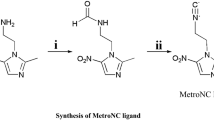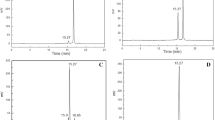Abstract
The [99mTcN(PNP)]2+ core offers a unique route for the preparation of asymmetric 99mTc-complexes. Though bidentate chelators such as dithiocarbamates are most commonly used ligands in this approach, present study explores the possibility of using a monodentate ligand, a isocyanide derivative of metronidazole (MetroNC), for preparing a 99mTcN(PNP) complex for detecting tumor hypoxia. MetroNC could be prepared in good yield and subsequently radiolabeled with [99mTcN(PNP)]2+ precursor complex prepared from [99mTcN]2+ core and N-(2-methoxyethyl)-2-(diphenylphosphino)-N-(2-(diphenylphosphino)ethyl)ethanamine (PNP2) ligand. Preliminary biodistribution studies showed tumor uptake pattern similar to previous studies wherein, about 75 % of the tumor activity observed at 60 min post injection (p.i.) was still found to remain in tumor at 180 min p.i.




Similar content being viewed by others
References
Wiebe LI, Machulla HJ (1999) In: Machulla HJ (ed) Imaging hypoxia. Kluwer Academic Publishers, Netherlands
Ballinger JR (2001) Imaging hypoxia in tumors. Semin Nucl Med 31:321–329
Mees G, Dierckx R, Vangestel C, Van de Wiele C (2009) Molecular imaging of hypoxia with radiolabelled agents. Eur J Nucl Med Mol Imaging 36:1674–1686
Brizel DM, Scully SP, Harrelson JM, Layfield LJ, Bean JM, Prosnitz LR, Dewhirst MW (1996) Tumor oxygenation predicts for the likelihood of distant metastases in human soft tissue sarcoma. Cancer Res 56:941–943
Krohn KA, Link JM, Mason RP (2008) Molecular imaging of hypoxia. J Nucl Med 49(Suppl 2):129S–148S
Grunbaum Z, Freauff SJ, Krohn KA, Wilbur DS, Magee S, Rasey JS (1987) Synthesis and characterization of congeners of misonidazole for imaging hypoxia. J Nucl Med 28:68–75
Sorger D, Patt M, Kumar P, Wiebe LI, Barthel H, Seese A, Dannenberg C, Tannapfel A, Kluge R, Sabri O (2003) [18F]Fluoroazomycinarabinofuranoside (18FAZA) and [18F]fluoromisonidazole (18FMISO): a comparative study of their selective uptake in hypoxic cells and PET imaging in experimental rat tumors. Nucl Med Biol 30:317–326
Foo SS, Abott DF, Lawrentschuk N, Scott AM (2004) Functional imaging of intratumoural hypoxia. J Mol Imaging Biol 6:291–305
Lee ST, Scott AM (2007) Hypoxia positron emission tomography imaging with 18F-fluoro misonidazole. Semin Nucl Med 37:451–461
Komar G, Seppänen M, Eskola O, Lindholm P, Grönroos TJ, Forsback S, Sipilä H, Evans SM, Solin O, Minn H (2008) 18F-EF5: a new PET tracer for imaging hypoxia in head and neck cancer. J Nucl Med 49:1944–1951
Rajendran JG, Krohn KA (2015) F-18 fluoromisonidazole for imaging tumor hypoxia: imaging the microenvironment for personalized cancer therapy. Semin Nucl Med 45:151–162
Bonnitcha PD, Bayly SR, Theobald MB, Betts HM, Lewis JS, Dilworth JR (2010) Nitroimidazole conjugates of bis(thiosemicarbazonato)64Cu(II)—potential combination agents for the PET imaging of hypoxia. J Inorg Biochem 104:126–135
Zha Z, Zhu L, Liu Y, Du F, Gan H, Qiao J, Kung HF (2011) Synthesis and evaluation of two novel 2-nitroimidazole derivatives as potential PET radioligands for tumor imaging. Nucl Med Biol 38:501–508
Mallia MB, Subramanian S, Mathur A, Sarma HD, Venkatesh M, Banerjee S (2010) Synthesis and evaluation of 2-, 4-,5-substituted nitroimidazole-iminodiacetic acid-99mTc(CO)3 complexes to target hypoxic tumors. J Label Compd Radiopharm 53:535–542
Mallia MB, Kumar C, Mathur A, Sarma HD, Banerjee S (2012) On the structural modification of 2-nitroimidazole-99mTc(CO)3 complex, a hypoxia marker, for improving in vivo pharmacokinetics. Nucl Med Biol 39:1236–1242
Mallia MB, Subramanian S, Mathur A, Sarma HD, Venkatesh M, Banerjee S (2008) On the isolation and evaluation of a novel unsubstituted 5-nitroimidazole derivative as an agent to target tumor hypoxia. Bioorg Med Chem Lett 18:5233–5237
Mallia MB, Subramanian S, Banerjee S, Sarma HD, Venkatesh M (2006) Evaluation of 99mTc(CO)3 complex of 2-methyl-5-nitroimidazole as an agent for targeting tumor hypoxia. Bioorg Med Chem 14:7666–7670
Mallia MB, Subramanian S, Mathur A, Sarma HD, Banerjee S (2014) A study on nitroimidazole-99mTc(CO)3 complexes as hypoxia marker: some observations towards possible improvement in vivo efficacy. Nucl Med Biol 41:600–610
Giglio J, Fernandez S, Pietzsch HJ, Dematteis S, Moreno M, Pacheco JP, Cerecetto H, Rey A (2012) Synthesis, in vitro and in vivo characterization of novel 99mTc-’4+1’-labeled 5-nitroimidazole derivatives as potential agents for imaging hypoxia. Nucl Med Biol 39:679–686
Fernandez S, Dematteis S, Giglio J, Cerecetto H, Rey A (2013) Synthesis, in vitro and in vivo characterization of two novel 68Ga-labelled 5-nitroimidazole derivatives as potential agents for imaging hypoxia. Nucl Med Biol 40:273–279
Liu S, Edwards DS (1999) 99mTc-labeled small peptides as diagnostic radiopharmaceuticals. Chem Rev 99:2235–2268
Banerjee S, Pillai MRA, Ramamoorthy N (2001) Evolution of Tc-99m in diagnostic radiopharmaceuticals. Semin Nucl Med 4:260–277
Banerjee SR, Maresca KP, Francesconi L, Valliant J, Babich JW, Zubieta J (2005) New directions in the coordination chemistry of 99mTc: a reflection on technetium core structures and a strategy for new chelate design. Nucl Med Biol 32:1–20
Baldas J, Bonnyman J (1985) Substitution reactions of 99mTcNCl4 −—a route to a new class of 99mTc-radiopharmaceuticals. Int J Appl Radiat Isot 36:133–139
Alberto R, Schibli R, Egli A, Schubiger PA, Abram U, Kaden TA (1998) A novel organometallic aqua complex of technetium for the labeling of biomolecules: synthesis of [99mTc(H2O)3(CO)3]+ from [99mTcO4]− in aqueous solution and its reaction with a bifunctional ligand. J Am Chem Soc 120:7987–7989
Pasqualini R, Comazzi V, Bellande E, Duatti A, Marchi A (1992) A new efficient method for the preparation of 99mTc-radiopharmaceuticals containing the TcN multiple bond. Appl Radiat Isot 43:1329–1333
Marchi A, Rossi R, Marvelli L (1993) Nitrido-technetium (V) complexes with amino acids: preparation and X-ray crystal structure of the l-cysteinate ethyl ester technetium (V) complex. Inorg Chem 32:4673–4674
Pasqualini R, Duatti A, Bellande E, Comazzi V, Brucato V, Hoffschir D, Fagret D, Comet M (1994) Bis(dithiocarbamato) nitrido technetium-99m radiopharmaceuticals: a class of neutral myocardial imaging agents. J Nucl Med 35:334–341
Bolzati C, Boschi A, Uccelli L, Tisato F, Refesco F, Cagnolini A, Duatti A, Prakash S, Bandoli G, Vittadini A (2002) Chemistry of the strong electrophilic metal fragment [99Tc(N)(PXP)]2+ (PXP = diphosphine ligand). A novel tool for the selective labeling of small molecules. J Am Chem Soc 124:11468–11479
Bolzati C, Mahmood A, Malago E, Uccelli L, Boschi A, Jones AG, Refesco F, Duatti A, Tisato F (2003) The [99mTc(N)(PNP)]2+ metal fragment: a technetium-nitrido synthon for use with biologically active molecules. The N-(2-methoxy phenyl) piperazyl-cysteine analogues as examples. Bioconjug Chem 14:1231–1242
Bolzati C, Benini E, Cazzola E, Jung C, Tisato F, Refesco F, Pietzsch HJ, Spies H, Uccelli L, Duatti A (2004) Synthesis, characterization and biological evaluation of neutral nitride technetium (V) mixed ligand complexes containing dithiolates and aminodiphosphines. A novel system for linking technetium to biomolecules. Bioconjug Chem. 15:628–637
Mathur A, Mallia MB, Banerjee S, Sarma HD, Pillai MRA (2013) Preparation and evaluation of a 99mTcN-PNP complex of sanazole analogue for detecting tumor hypoxia. Bioorg Med Chem Lett 23:1394–1397
Bolzati C, Cavazza-Ceccato M, Agostini S, Tokunaga S, Casara D, Bandoli G (2008) Subcellular distribution and metabolism studies of the potential myocardial imaging agent [99mTc(N)(DBODC)(PNP5)]+. J Nucl Med 49:1336–1344
Taillefer R, Laflamme L, Dupras G, Picard M, Phaneuf DC, Leveille J (1988) Myocardial perfusion imaging with 99mTc-methoxy-isobutyl-isonitrile (MIBI): comparison of short and long time intervals between rest and stress injections. Eur J Nucl Med 13:515–522
Baker RJ, Bellen JC, Fornasiero D, Penglis S (1986) The preparation of 99mTc-tertiarybutylisonitrile (99mTc-TBI) by a method suitable for routine clinical use. Int J Radiat Appl Instrum B 13:527–532
Kothari KK, Satpati D, Joshi S, Venkatesh M, Ramamoorthy N, Pillai MR (2005) 99mTc carbonyl t-butyl isonitrile: a potential new agent for myocardial perfusion imaging. Nucl Med Comm. 26:155–161
Zhang XZ, Wang XB, Jia F, Tang ZG, Zhang JB, Liu BL (2002) Preparation, characterization and biodistribution of a new technetium-99m nitrido complex with 2-methoxyisobutylisomtrile and comparison with Tc-99m-MIBI. J Label Compd Radiopharm 45:1029–1043
Zhang XZ, Wang XB, Zhou JM (2001) Preparation, characterization and biodistribution of a new technetium-99m nitrido complex with cyclohexylisonitrile. J Label Compd Radiopharm. 44:S651–S653
Zhang XZ, Wang XB, Zhou JM (2003) A new technetium-99m labeled isonitrile complex 99mTc-TMCHI as a potential blood pool imaging agent. Appl Radiat Isot 59:231–235
Dhake KP, Tambade PJ, Singhal RS, Bhanage BM (2011) An efficient, catalyst and solvent free N-formylation of aromatic and aliphatic amines. Green Chem Lett Rev 4:151–157
Kobayashi G, Saito T, Kitano Y (2011) A novel method for preparing isocyanides from N-substituted formamides with chlorophosphate compounds. Synthesis 20:3225–3234
Mallia MB, Mathur A, Subramanian S, Banerjee S, Sarma HD, Venkatesh M (2005) A novel [99mTcN]2+ complex of metronidazole xanthate as a potential agent for targeting hypoxia. Bioorg Med Chem Lett 15:3398–3401
Giglio J, Fernandez S, Rey A, Cerecetto H (2011) Synthesis and biological characterization of novel dithiocarbamate containing 5-nitroimidazole 99mTc-complexes as potential agents for targeting hypoxia. Bioorg Med Chem Lett 21:394–397
Acknowledgments
The authors gratefully acknowledge the support and encouragement provided by Dr. K. L. Ramakmar, Director Radiochemistry & Isotope Group, Bhabha Atomic Research Centre. The authors acknowledge the supply of Molybdenum-99 by Radiochemicals Section, Isotope Production and Application Division. The help rendered by the staff members of the animal house facility of Radiation Biology and Health Sciences Division, is also acknowledged.
Author information
Authors and Affiliations
Corresponding author
Rights and permissions
About this article
Cite this article
Vats, K., Mallia, M.B., Mathur, A. et al. Synthesis and evaluation of a novel 99mTcN(PNP)-complex with metronidazole isocyanide ligand as a marker for tumor hypoxia. J Radioanal Nucl Chem 308, 363–369 (2016). https://doi.org/10.1007/s10967-015-4526-2
Received:
Published:
Issue Date:
DOI: https://doi.org/10.1007/s10967-015-4526-2




